
The Megalithic Monuments of Ancient Egypt, Pt. 1
As we have just celebrated our 7th anniversary of this Biblical Astronomy blog, we have a number of blogs posted on the Archaeology of Ancient Egypt, but this posting takes a different approach, in that it considers the temporal context of structures like the Great Pyramid, the Great Sphinx and it’s nearby temples, with other buildings featuring ancient megalithic architecture in Egypt.
John Anthony West and Robert Schoch have provided strong geological evidence that the Great Sphinx is much older than the Archaeological establishment has been telling us. Dr. Schoch via his water erosion statistics on the Great Sphinx, holds that the origins of the oldest known stone monument on the face of the earth are closer to the 5-7000 BC era, instead of the conventional chronology of circa 25-2700 BC era. This puts the potential origins of the Great Sphinx in the Antediluvian or the pre-Noah’s Flood Age. This also puts the incept date of the Great Sphinx before the Ancient Egyptian Old Kingdom Pharaohs.1 Dr. Schoch’s water erosion data is convincing and solid scientific evidence, but is there evidence beyond ancient weather patterns of Paleo-Climatology studies showing a greater age for the Great Sphinx? It is notable that this water erosion data would be consistent with dating of Noah’s Flood scenario of the Great Sphinx, along with increased rainfall prior to the Sahara Desert appearing with its elevated surface temperates and decreased rain patterns in the post-diluvian world, around the Giza Plateau. Other elements to consider for an older Sphinx include the Great Sphinx Temple and Valley Temple. 2
In building the Great Sphinx’ adjoining temple, quarried stone blocks of over 200 tons were used, with some of this Sphinx temple masonry matching stone-work in building the Pyramids. This includes the causeway connecting the Giza Pyramids to the Great Sphinx, showing linkage between these uniquely historic monuments on a number of levels. It is logical that some of the quarried blocks were used to construct the Sphinx Temple, as the Sphinx was carved out of existing rock at the same site. The matching Architectural style found in the Great Pyramid, Great Sphinx and Sphinx Temple, produced with the same technology, unmatched in the modern world, capable of precise placement of these massive Limestones, is a key identifying feature setting the required expertise apart from the mud bricks for example, of the nearby Saqqara Pyramid, that conventional Archaeology maintains to be older than the megalithic Giza Structures. Yet if the Saqqara mud-bricks were older than the Giza megalithic structures, and subject to the weather patterns as the structures of the Giza Plateau, the mud-bricks would have crumbled long ago, as Saqqara is only 10 miles away from the Giza Plateau. 3 This evidence presents a major hole in the hypotheses of Conventional Archaeology, revealing inconsistencies in their efforts to protect their special interests.

With the exception of a few die-hards, most egyptologists consent to the accumulating body of archaeological and geological evidence, indicating that the Sphinx dates much older than the 4th Dynasty, and that the Sphinx was only restored by Chephren, not built during his reign. The Inventory Stela provides strong circumstantial evidence, by Khufu himself, that he or Kephren did not build the Great Pyramid, and that the Pyramid and Sphinx, already existed during his reign. Egyptologists like James H. Breasted, included the Inventory Stela in his official list of Egyptian artifacts, stating that it “bore all the marks of authenticity.” Also, the French Egyptologist Gaston Maspero whose well-known work, “The Dawn of Civilization,” stated that the stela was indeed a factual record of the life and deeds of Khufu.
Conventional Scholars have rejected the Inventory stela due to seemingly more modern stylized writings on the Stela, but this evidence becomes more robust as the story deepens. The ‘Inventory Stele‘ found near the Sphinx in the 19th century relates that Pharaoh Cheops/Khufu; Chephren’s predecessor – ordered a temple built beside the Sphinx, meaning the Sphinx already existed at this earlier time, and thus was not built by Chephren. Additional evidence from West and Schoch has solidified this theory. They expanded their weathering data on the Great Sphinx, including weathering differentials between the front and back half of the Great Sphinx.4 This evidence shows the front half of the Great Sphinx appears to be about twice the age as the rear of the Sphinx. Dating the rump of the Sphinx, it shows dates more consistent with Pharoah Kephren [circa 2500 BC], while the front half of the Sphinx exhibits dates from 5-7000 BC, according to Schoch’s erosion /weathering data.
Dr. Schoch’s erosion rates translate to about a foot of erosion every 100 years on the Great Sphinx. Since Conventional Archaeology holds to the Sphinx aged to about 4500 years, a problem arises when we consider that the Great Sphinx is only about 40 feet wide. There does not appear to be enough of the Great Sphinx to support the dating of Conventional Archaeology, since at these documented erosion rates, the Sphinx would have vanished about 500 years ago! This also begs the question in light of the colossal age and durability of the Megalithic Giza Monuments; If Kephren was indeed responsible for building the Great Sphinx, why would it be in need of repairs only 2-300 years later? 5
This evidence would potentially support the idea that Chephren renovated a Great Sphinx whose front half already existed, as supported by the Inventory Stela, while potentially adding the rump of the Great Sphinx as the newer addition, explaining the lesser age of the Sphinx’ rear. The history of efforts to repair the Great Sphinx in ancient Egypt date back to the Old Kingdom, [circa 2700 BC] which ended 200 years after Kephren’s death. This is further evidenced by hieroglyphs found in a style typical of the Old Kingdom, on the Sphinx Temple Granite Wall, showing this wall was present during Old Kingdom times, but the limestone blocks used to build the Valley Temple are older than the Granite Wall inscription. This tells us that the Valley Temple was built much earlier than the Old Kingdom, supporting the fact that Kephren did not build the Great Sphinx.
To put it in Dr. Shoch’s words; “If the granite facing is covering deeply weathered limestone, the original limestone structures must predate by a considerable degree the Granite facing. Obviously, if the limestone cores [from the Sphinx ditch] of the temples predate the granite facings, and these granite ashlars are attributable to Kaphre of the IVth Dynasty, then the Sphinx Complex was built before the reign of Kaphre.”6
It also suggests a master-plan for the blueprints to build these elements of the Giza Plateau including the Sphinx, its Temples and the Pyramids. Since these ancient megalithic Giza structures are characterized by unique technology that remains beyond the capabilities and engineering of the modern world, Conventional Archaeology has challenged Archaeologists like Shoch and West, to show similar examples of Megalithic Architecture from the same or similar period of Egyptian History. With this in mind, we present the following examples of Megalithic evidence from ancient Egypt.
The Base floor of the Temple of Hathor, at Dendera on the west bank of the Nile a little over 600km from Cairo, consists of megalithic stone flooring very similar to that found at the base of the Giza Pyramids, not to mention other ancient megalithic structures forming the pavement of the temples in Puma Punku, Bolivia. “The worship of Hathor in ancient Egypt dates back to Pre-dynastic times, [5500-3100BC] as Egypt’s main female deity. This Temple of Hathor was one of many centers of worship for the “Cow Goddess” and daughter of Ra, who inspired long sustained adoration evidenced with a series of shrines and temples, built and rebuilt by Pharaoh’s and Roman emperor’s alike.” 7
Figure A. Megalithic Flooring outside the Temple of Hathor in Egpyt. 8
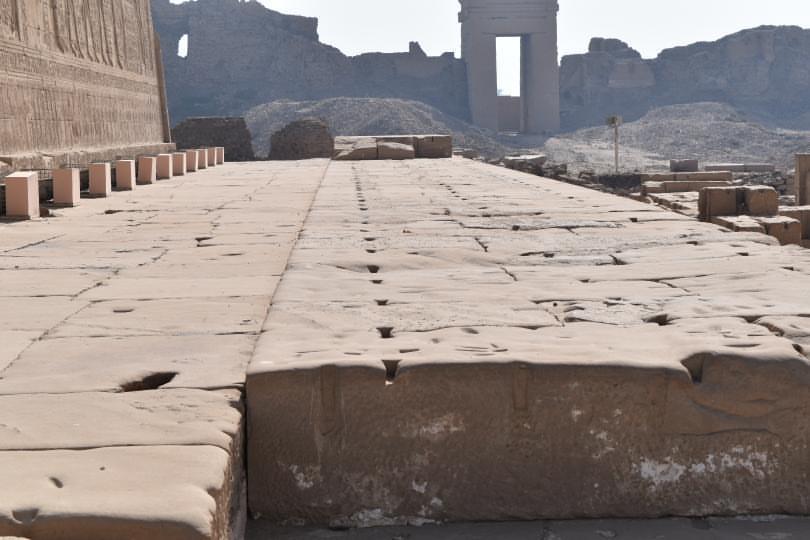
As we have seen in previous blogs the origin and purpose of the Great Sphinx has its roots in astronomy. The stellar function of the Great Sphinx is augmented by the role of the Sphinx as a sighting device, tying directly to one of its astronomical uses, to observe and record the horizon points of the sunrise, as documented by Moses Cotsworth. This aspect of the Sphinx brings new light as taken with its astronomical origins found in the Dendera Zodiac, in Esneh, Egypt. Since the Dendera Zodiac was found in the Temple of Hathor at Dendera, we find another link in the ancient sites based on Megalithic structures of Egypt. What is fascinating about the Dendera Zodiac is that it provides the blueprints for the structure of the Great Sphinx, as the Alpha and Omega signs of the Mazzaroth or zodiac, and the astronomical basis for the Sphinx!
Figure 1. The Dendera Zodiac with Sphinx Insert. 9
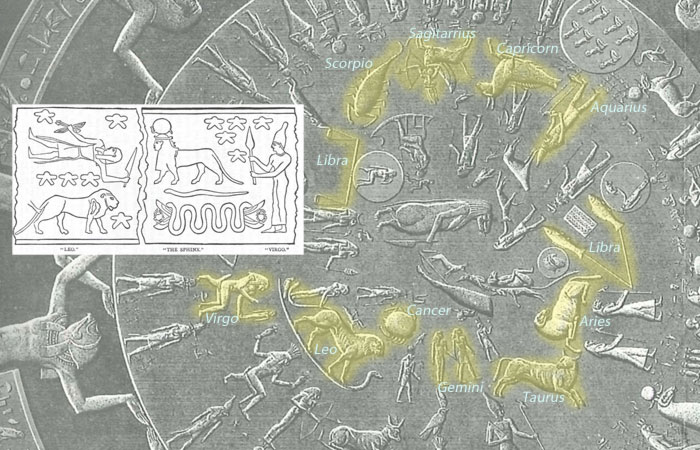
Job 19:23-25 [Revised English Bible]
Would that my words be written down! Oh, that they were engraved in an inscription! [24] That they were graven with an iron pen and filled with lead, carved in the rock forever! [25] For I know that my redeemer lives, and that he shall stand at the latter day upon the earth: [KJV]
These verses show the ancient Patriarch–Job’s knowledge prophesying of his coming redeemer, and of his faith that his redeemer would stand at a future day upon the earth. His knowledge directly corresponds both, to a witness engraved in rock forever, remaining unto our day, that testifies to the celestial and written gospels. The word “For,” beginning verse 25, grammatically depicts the purpose of Job’s reference to a monumental witness in stone, whose longevity remains into our day, as a witness to the redeemer that Job foresaw so long ago. Thus Job’s reference, in this majestic declaration of his redeemer, graven in rock forever, is readily linked with this enduring memorial on the Giza plateau, analogous with the prophecy written in the stars between Leo and Virgo, seen in the Alpha/Omega signs of the Mazzaroth-the Great Sphinx. Job’s words certainly stand out as a reference to the witness of the stars in stone, a witness God provided to the Biblical Patriarchs written by Job, enshrining the sacred stone landmarks of the Great Sphinx and the Great Pyramid [Job 38:4-7, Isa. 19:19-20] as unique Biblical testaments of the truths of the Celestial and Scriptural Gospels.
It is a known historical and archaeological fact that the Great Sphinx was carved out of a rock formation on the Giza plateau, which is consistent with the testimony of God’s Word in Job 19:23-5, where the word “rock” [*H6697] means “a cliff, sharp rock compressed, or boulder.”10 Unlike the other structures on the Giza Plateau which were built with large stone blocks, this specific description of the Great Sphinx as “graven” from existing rock–only fits the Great Sphinx. The word “graven” [chaqaq] *H2710 in Job 19:24 means: to cut, carve, hew, mason, quarry, or engrave. 11
Generally, the Astronomical evidence for the age of the Great Sphinx has been ignored at this writing, which has also had a detrimental effect on the witness of a Gospel in the Stars, supported by the divine order of the constellations starting with Virgo, ending with Leo the Lion, which embody the Celestial Gospel, [Ps. 19].
The 10 constellations between these Alpha and Omega signs along with their 36 decans, complete the 48 signs that convey the gospel message. The Figure 1 image of the inset graphic, comes from the Square Dendera Zodiac in the Esne Temple seen in Fig. 2 below, where images of Virgo and Leo with the Sphinx between them are found on the left side of this rectangular zodiac.
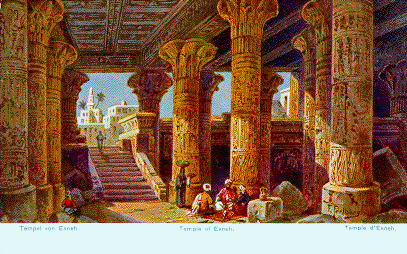
Figure 2. Square Dendera Zodiac from the Temple of Esne. 13

The image of the Great Sphinx is derived from the left side of this square zodiac consisting of upper and lower rectangles showing Virgo and the Sphinx in the lower rectangle and Leo the Lion in the upper rectangle. We have focused on this enlarged image below, where the composite Sphinx image between Virgo and Leo is crowned with an Egyptian Solar Disc, above a circular crown on Virgo’s head, perhaps indicating the Sun in Virgo/ Leo.
Figure B. Enlarged inset graphic of Virgo and Leo originating the Great Sphinx. 14

The inset graphic on the Fig. 1 circular Dendera Zodiac above, is from the Esneh Temple, where an image of a Sphinx was put between the signs for Leo (on the lower left) and Virgo (on the right, holding a branch). The word sphinx means “to bind closely together” (from the Grk-Sphiggo), depicting the point where the 12 signs of the Mazzaroth/ constellations begin and end. And, like the female head of the Sphinx, the constellations begin with Virgo, and end in the Sphinx’s lion tail, with Leo. This reveals the astronomical purpose of the Mazzaroth’s divine order in the Great Sphinx that unlocks the age-old mystery of the Mazzaroth, consistent with the themes of the Gospel in the Stars, that were taught by Biblical OT Patriarchs like Seth and Enoch. This is supported by strong ancient traditions in Egyptian Myth, where Enoch holds a key place as the embodiment of Thoth-the god of wisdom, and as the divine scribe-recorded the King’s deeds in his reign.
Thoth/Hermes, and Enoch were revered in their links to the invention of writing and sacred books. With common celestial roots where-Hermes ostensibly recorded 36,525 books and lived 365.25 years, while Enoch also lived 365 years, [Gen. 5:23] matching the number of days in the solar, or Sothic year. This stands out as an anomaly among all of Enoch’s OT Patriarchal relatives with life spans in excess of 895 years with the exception of Lamech who lived 777 years. Enoch was also the 7th from Adam, who walked with God, in the antediluvian age before Noah’s Flood. In later Judeo-Christian lore, descendants of Seth, including Enoch were credited with planning and building two pillars, one of which coincides with the Great Pyramid of Giza, and the other maybe the Great Sphinx, encoded with prophetic wisdom “in the Siriadic land,” referring to Egypt, the land of Sirius. 15
Amazingly, the dimensions of the Great Pyramid also support this idea because; “the ratio of the Pyramid’s base perimeter to its height is none other than twice the quantity of pi. In other words, the Great Pyramid’s height is to its base perimeter as a circle’s radius is to its circumference. Using the Sacred cubit measurement, every one of the Pyramid’s basic external and internal measures can thus be expressed as a function of the quantities pi and 365.242. The Great Pyramid’s extraordinary geometry not only combines all the above data into a single elegant identification of the planet upon which we live, but it also gives these quantities durable expression in terms of themselves.”16
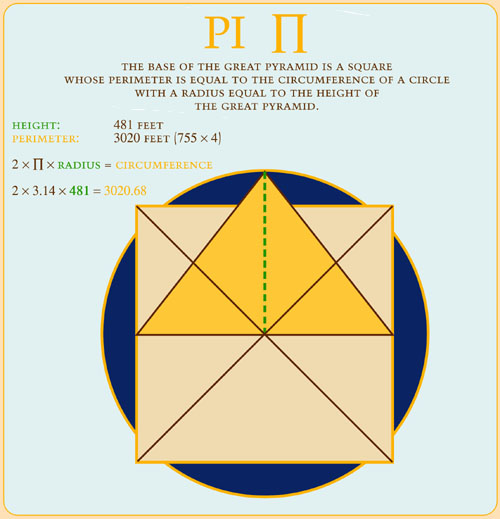
If the goal was to depict Enoch’s role in the design and building of the Great Pyramid, what better way is there than to link Enoch’s out of place, signature life span of 365 years to the design and calendrical aspects of the Great Pyramid, in the absence of a complete written record? Like Joseph the Patriarch Jacob’s Son, who followed in Enoch’s steps as a Biblical non-Egyptian, who made a name for himself and a huge difference in the history of Egypt as ambassadors for the True God.
The larger image in Figure 1 above is from the Dendera zodiac taken from the ceiling of a Portico dedicated to Osiris in the temple of Hathor in Dendera, Egypt. “We find added indicators of the antiquity of this temple site in the astronomical alignment of the main temple to Gamma Draconis before 5000BC. Early texts refer to a Pre-dynastic temple that was rebuilt during the Old Kingdom, and further developed by New Kingdom Pharaohs including Thutmose III, Amenhotep III, and Ramses II and III. The present structure dates to the Greek and Roman periods, with the sanctuary and its enclosed surrounding chapels built by the later Ptolemies in the 1st century BC.”17
The Dendera Zodiac labels the 12 main constellations with their Decans. The bas-relief is dated variously from 5000+ BC to 50 BC, and is currently displayed at the Louvre in Paris. Since orthodox archaeology only dates the Sphinx back to the 4th Dynasty reign of Pharaoh Khufu-whose face they hold is that of the Sphinx, their dating of the Great Sphinx goes back to his reign around 4600 years ago. This theory rests on scant real evidence, and Khufu’s face on the Great Sphinx rests on little beyond conjecture. Dr. Schoch’s solid scientific archaeological & geological evidence based on water erosion, dates the Great Sphinx to 5-7,000 BC. Geologists agree that ancient Egypt faced rains & flooding that has impacted much wear to the exterior of the Great Sphinx. Other than the evidence presented here; [Job 19:23-25], there are no known ancient historical records that mention the Great Sphinx, or its carving, so the astronomical purpose for the Great Sphinx, supported in the Dendera zodiac is some of the most solid evidence that has yet surfaced. This being the case, it deserves much more attention than has been paid by orthodox archaeology, who have ignored these records with the silent treatment for decades if not centuries.
The Astronomical purposes of the Great Sphinx are found first as a prime aspect of the heavenly signs linked to the Celestial Sphinx where we find unique planetary conjunctions that took place marking the Birth of Jesus Christ, in the constellations of Virgo and Leo. Since these are the zodiac signs that constitute the Alpha-Omega signs of the Mazzaroth, forming the Celestial Sphinx, it provides a living practical example of Biblical Astronomy which the Great Sphinx itself memorializes. As a central example of Biblical Archaeo-Astronomy, the Great Sphinx is a true living artifact of the divine science of Biblical Astronomy that the Creator still utilizes today, marking the heavenly signs of the Second Coming of His only Begotten Son. In this vein, we highlight the relief from the ceiling of the Temple of Esneh; [Fig. C], where the basic stellar figures of Virgo and Leo are unified in the Great Sphinx, pictured with the solar disk crowning the head of the woman-“sun clothing Virgo,” [Rev. 12:1] who is joined with the body of the Lion, over the serpent Hydra. This clear stellar image found at the Esne temple site housing the Dendera zodiac, provides strong archaeological support, not for the union of Virgo and Leo only, affirmed in the two stellar aspects of the Sphinx monument, but also the exaltation of the woman-Virgo. She is pictured at the right below, prominently holding her grain stalk, or branch [Al Zimach] as she appears in Dendera’s zodiac, symbolizing her bearing the promised seed, the light of the world. This ancient Egyptian archaeological hieroglyph on the Dendera Zodiac is a key piece of history in Biblical Archaeo-Astronomy narrative, that sheds new light on the Great Sphinx, prophesying of the Birth of Christ the Promised Seed.
Figure C. Ceiling Relief from the Ancient Egyptian Temple of Esneh. 18
|
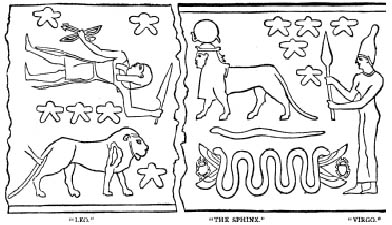 |
This sets the basic context of the original function of the Great Sphinx, including:
- The unity of the Biblical Mazzaroth starting at Virgo and ending in Leo, summarizing the truths of Biblical Astronomy and Archaeo-Astronomy. These are the Alpha and Omega points of the circle of the zodiac or Mazzaroth, since the circular path of the Sun upon the ecliptic turns ever round through the 12 signs. The birth of the Sun of God is seen in Virgo [Rev. 12:1-2] and his destruction of the dragon/serpent is evident under Leo’s paws.
- The original role of the Sun in this context of “clothing Virgo,” along with embodying the solar aspects of the Sphinx gains added meaning as the Son of Righteousness, runs his allotted race. [Ps. 19:4-5]
- The Great Sphinx blueprints from the Square Zodiac found in the Temple of Esne, shows Virgo the woman holding her branch/seed on the right, with Leo the Lion on the left. Between them, we find the Lion’s body with the head of the woman crowned with a circular crown, and the Sun on her head. This embodies Ps. 19. as the Sun moving through his tabernacle as a bridegroom [v.4-5] rejoicing as a strong man to run his race completing the circuit of heaven. This represents the circular Crown as the 12 signs on the ecliptic on Virgo’s Head.
A Stone monument memorializing these truths parallel the witness to the Coming Redeemer found in the Stars and in Scripture. The sign Virgo emphasizes her fertility or motherhood, as she holds in her right hand a branch, or staff, also a title applied to the Messiah as the offspring of David, and in her left hand some sheaves of corn, or seeds of wheat (ear of grain, spike of wheat (Spica). The star Spica, in Virgo, which appears to be only one of two specific stars shown on Dendera’s zodiac, the other being Sirius, embodies the Promised Seed-Jesus Christ in a four-fold ministry as King, Son of Man, Servant and Son of God, as seen in the Four Gospels; Matthew, Mark, Luke and John.
Rev. 22:12-13
12 “And behold, I am coming quickly, and My reward is with Me, to give to every one according to his work. 13 I am the Alpha and the Omega, the [f]Beginning and the End, the First and the Last.”
Jesus is the Alpha and Omega not only in Scripture from Genesis to the end of Revelation, but also from Virgo to Leo in the Celestial Gospel of the Mazzaroth, represented in the Great Stone Monument of the Sphinx on the Giza Plateau. This also shows multiple examples of the Biblical figure of speech-[merismos] as in Acts 2:19-20 referring to astronomical and spiritual renditions of this figure in the Scriptures. With this in mind, let’s look at some specific stellar aspects of the Great Sphinx.
Stellar Elements of the Great Sphinx
There are at least three categories of Celestial Sphinx signs. The first is in a class by itself, that we find in Fig. D. Here, the head of the woman Virgo, clothed with the sun is rising above the horizon as seen from Jerusalem, with the full body of Leo the Lion, already risen. As a marker for the birth of Christ highlighting these two major components of the Great Sphinx, this sign certainly is worthy of our special attention. A second category of signs along these lines is seen also when the Sun is clothing Virgo. During this time of year, a period of about 20 days length, if planetary unions occur in both Leo and Virgo, the two stellar aspects of the Celestial Sphinx are thus highlighted. An example of this was seen in the signs surrounding the birth of Christ, from September 9th to the 14th in 3 BC. Fig. D shows the first of three conjunctions of Jupiter and Regulus in Leo first visible, as the heavenly signs marking the birth of Christ took place September 11th, in Virgo. The original teaching of the witness of the signs of the mazzaroth is encapsulated in the zodiac signs Virgo and Leo and preserved in this ancient monument of the Giza plateau, the Great Sphinx. An interesting astronomical truth in support of this lies in the fact that the crowned head of Virgo actually bridges about 10 degrees into the sign Leo on the ecliptic. This is evident in connection with the star Denebola, in the lion’s tail. The star named Sarcam in Leo, is a Hebrew word meaning “the joining,”19 marking the point where the two ends of the Zodiacal circle have their joining. This is borne out in the sign Corvus, the bird of prey devouring the sea-monster Hydra, a decan of Virgo. The bright star in the eye of Corvus the Raven, called Al Chibar in Arabic means “joining together,”20 referring also to the union of these two ends of the true zodiac! This is pictured in Figure E. below, depicting the Hydra a prominent sea–dragon constellation [Isa. 27:1], with Corvus the Raven and carrion eater, shown devouring the perishing remains of the Serpent destroyed, under Leo’s extended claws. This is the enemy’s destiny that we also find pictured in Fig. C. the Temple of Esne above, with the serpent under the Sphinx’ paws.
In 1811 Richard Wm. Hamilton was quoted in the Edinburgh Review showing a scholarly history of this view over 200 years ago in agreement with our position; “We believe the Sphinx to be the symbol of the Sun at the Summer Solstice, precisely at the point where the last degree of Leo meets the first degree of Virgo. The head of the woman joined to the body of the Lion seems to justify the explanation of the symbolic Sphinx.”21
Figure D. The Celestial Sphinx. 22
The Head of the Woman and the Body of the Lion as seen on Sept. 14th, 3 BC, on the eastern horizon from Palestine, forming the aspects of the Celestial Sphinx, marking the first Jupiter-Regulus Conjunction in Leo.
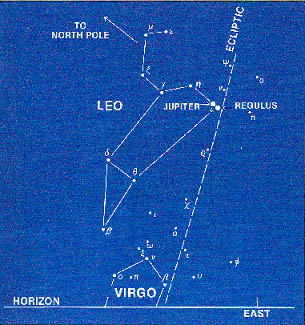
We find these landmarks at the head and tail of the zodiac, which adds light to Dr. Martin’s observation that: “the woman Virgo is the Constellation of Headship for all twelve signs. The head position of Virgo is located within the last 10 degrees of Leo.”23 Virgo’s head is seen in Fig. D, just below and adjacent to the star Denebola in the tail of the Lion, unifying the circle of the zodiac. When viewed in context with the witness of the Great Sphinx, this sign on 9-14-3 BC takes on added meaning, indicated in the Great Sphinx‘ two basic elements. These two elements are detailed in the movement of the King planet Jupiter entering Leo, the lion-body of the celestial Sphinx, while the Sun was in Virgo, the female head of this Sphinx. As the stars are allowed to speak in harmony with this witness in stone, the solitary guardian of the Giza plateau anticipates the dawning of a new day for mankind, as it predicts the birth of Spica, Virgo’s promised seed. Thus, the Great Sphinx and the Great Pyramid stand, as oracles, monumental prophets of both the Alpha and Omega, the first and second advents of Jesus Christ, revealing both his sufferings and glory. These stellar aspects of the Sphinx, supported by the picture of the eastern horizon during the early morning hours of September 14th, at the time of the first Jupiter-Regulus union. This distinct star picture of the Head of the woman Virgo rising above the horizon, with the body of the lion above her head, initiating the first of 3 Jupiter-Regulus unions, aligning the prophecy of the stars with the Scriptural prophecy of Genesis 49:8-10, is definitive evidence for our thesis. This triple conjunction of Jupiter-Regulus in Leo was bracketed by the two Jupiter-Venus conjunctions also in Leo between August 31st, 3 BC and June 17th 2 BC. The June 17th, 2 BC conjunction of Jupiter and Venus the bright and Morning Star, was a most notable and attention-grabbing heavenly sign marking the birth of Christ.
Figure E. Hydra the Sea-Serpent beneath Leo’s claws, with Corvus the Raven and Crater the Cup of God’s Wrath, attached to its back.
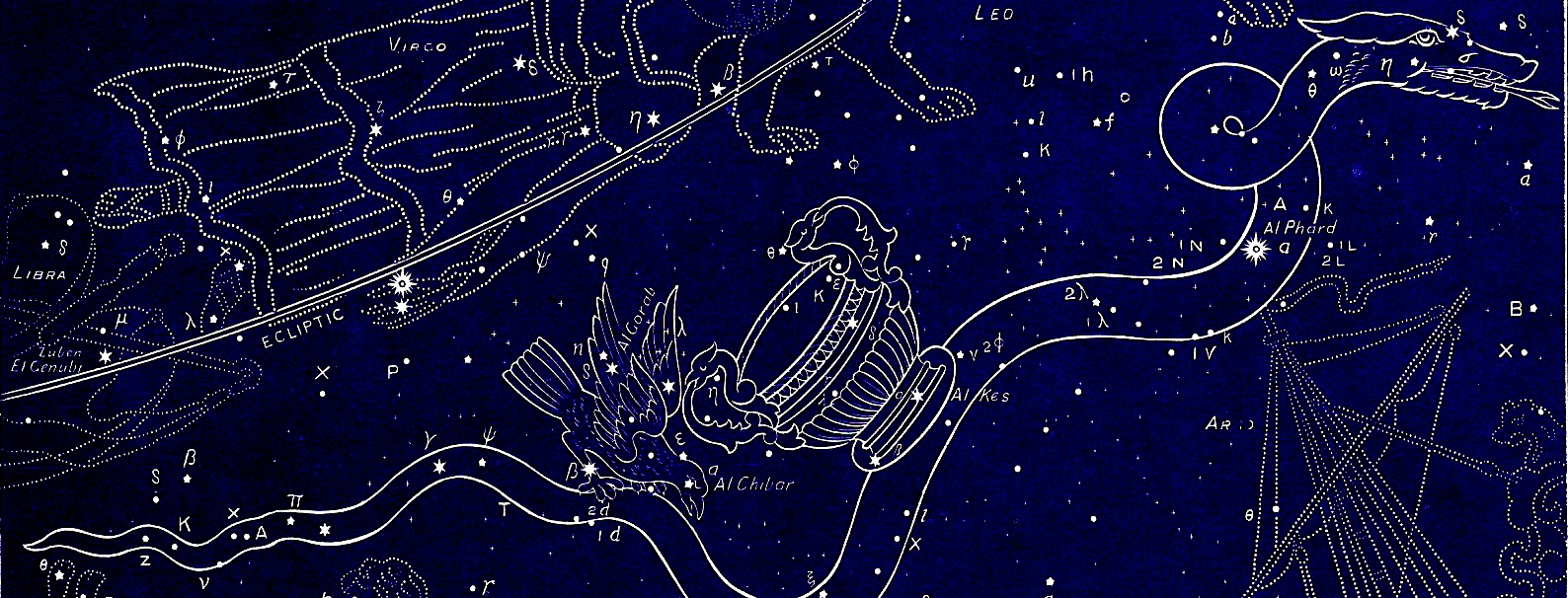
Not only does the Great Sphinx provide the divine order of the Mazzaroth as the Gospel in the Stars, but it also prophesies of the Birth of Christ with multiple celestial signs that occurred in Leo, the body of the Sphinx, as the Sunset in Virgo, the Sphinx’s head, on 9-11-3 BC. The unique crowning of the female head of the Sphinx is found in Figure C with a solar disc on Virgo’s head, as Virgo was clothed with the Sun, and the moon at her feet; [Rev. 12:1-2]. This ancient solar association with the Great Sphinx was later corrupted in Egypt in the astrological veneration of the Sun god-Ra.
The first dawn appearance of Leo at summer solstice would have signified to ancient observers circa 3000-2500 BC the opening of Nile Flood season. Since the star Sirius would be making its first dawn rising –known as a Heliacal Rising–at the same time, then the signal would be interpreted metaphorically as the sun entering or joining Leo in the horizon and the start of the Nile Floods, when also Sirius first became visible.
Figure 3. The Great Sphinx facing Leo at Sunrise on the Summer Solstice. 24

Graham Hancock explains in Heaven’s Mirror that, “computer simulations show that in 10,500 BC the constellation of Leo housed the sun on the spring equinox – i.e. an hour before dawn in that epoch Leo would have reclined due east along the horizon in the place where the sun would soon rise. This means that the lion-bodied Sphinx, with its due-east orientation, would have gazed directly on that morning at the one constellation in the sky that might reasonably be regarded as its own celestial counterpart. 25
Robert Bauval tells us the ancient Egyptians believed that their Pharaohs were earthly representations of a god they called Horakti. Another similar name used this way in Ancient Egyptian was Horemakhet, that Bauval says was used only for the Great Sphinx of Giza, whereas the name Horakti applied to a figure on the eastern horizon identified with the constellation of Leo the Lion. Bauval also sees problems with Kephren/Kaphre as the builder of the Great Sphinx, as seen in the following statement; “…there is a problem allocating the Great Sphinx to Kaphre, a king of the IVth Dynasty who reigned c. 2500 BC since the Great Sphinx is gazing directly DUE EAST, whereas the constellation Leo arose at that time some 28 degrees North of Due East.”26 This of course, is based on the assumption that if 2500 BC was the correct date for the construction of the Sphinx, then the Sphinx would align with Leo the Lion on the Horizon, marking the date of its building, which was not the case.
The Key Aspect of other Megalithic structures in ancient Egypt during the general period of the inception of the Giza structures is a primary consideration of this blog. Elements of the Great Sphinx Complex include the Sphinx, Valley Temple, and Sphinx Temple which were all built with the same materials. The Giant megaliths of this Temple, match their limestone blocks sourced from the Great Sphinx enclosure. 27 Not only is the Great Sphinx linked to Giza’s Pyramids via the surface causeway between the Sphinx and the second Pyramid, but also potentially with some other megalithic technology of ancient Egypt, via its hidden underground passages. At last inventory, there are three Sphinx tunnels that have been identified so far. One is in the front of the Sphinx, between its paws. A 2nd is on the Sphinx‘ North-side, and a third at the rear-near the Sphinx’ tail. Egyptologist Z. Hawass was able to enter this 3rd tunnel, for the first time as the tunnel was dug out during recent restorations of the Sphinx. Normally, Hawass is against alternative theories relating to Ancient Egyptian Archaeology, but in this case he stated his belief that three underground tunnels connect the Sphinx Complex to the Osireion and the Great Pyramid. 28
Figure 4. The Osireion- Perhaps The oldest Egyptian Temple [in Abydos]. 29
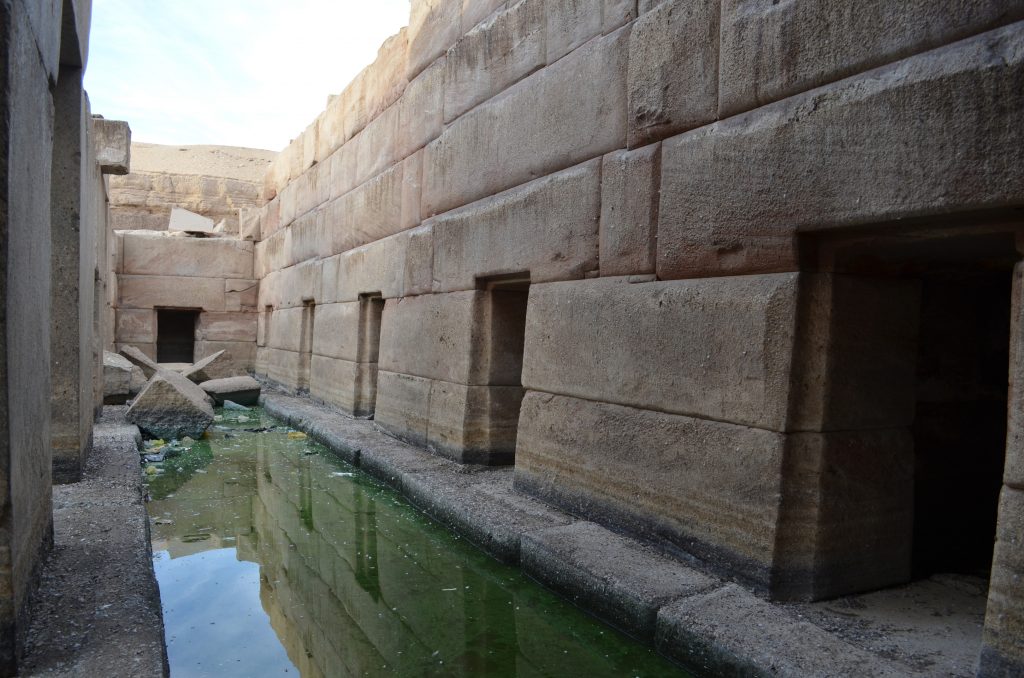
The 3rd Pyramid of Menakure also fits the megalithic signature of Giza, in that it’s casing stones at the base of the Pyramid display the same precision found at the Osireion. Potential passages linking these ancient megalithic sites would prove strong added evidence for the ancient culture that produced these collossal buildings during the same period, with a technology that remains beyond the building capacity of modern man. The Osireion Complex was originally covered with roof lintels of up to 200-ton blocks, placed atop the columns from above. These monoliths are heavier and placed with more precision than any other Egyptian building, and without any inscriptions, unlike other Egyptian funerary monuments. Considered the Tomb of Osiris, the Osireion is thought to be a contemporary of the Gobekli Tepe site in Turkey, widely considered the oldest archaeological site in the world. 30
A main reason why orthodox archaeology has suppressed and ignored the ancient astronomical evidence for the Great Sphinx, is that it undermines their theory of the origins and builders of the Sphinx, not to mention the other elements of the Giza Plateau. Obviously, if the origins of the Great Sphinx are based upon the evidence seen in the Dendera Zodiac, and the Sphinx horizon alignment, it not only washes out the cherished theory that the Sphinx was built by the Pharaoh’s Khufu/Kapfre, but it also credits Bible Patriarchs while showing the Sphinx as an ancient prophetic marker for Christ. However, these links between Dendera Zodiac and the Sphinx also raises the question; which came first: The Great Sphinx or the plans & blueprints for the Great Sphinx? Considering the potential age of the Sphinx, and its link to the Dendera Zodiac, it certainly shines new light on both the Sphinx and Dendera’s Zodiac, with the potential ages of both these historic artifacts, demanding a reconsideration of these ancient monuments and their important role in human history, our spiritual legacy and future of our planet. The wonder of these ancient Megalithic architectural master-pieces in pointing the way to the central figure in human history cannot be swept under the sands of the Sahara any longer. As these monuments witness to the birth and return of the Lord Jesus Christ, it demands our attention!
God Bless!
Rene’

Footnotes
1. The Mystery of the Sphinx, New Scientific Evidence [Director’s cut expanded for TV], Boris Said.
2. IBID
3. IBID
4. IBID
5. IBID
6. IBID
7. “Dating the Dendera Zodiac, Egypt’s famous Greco-Roman Zodiac.” Park and Eccles
8. https://www.theancientconnection.com/dendera-temple-hathor/
9. December 1, 2012 Asec
10. Strong’s Concordance, [H6697]. James Strong
11. IBID [H2710].
12. The Temple of Esneh as found on the “Egyptian Post Card Page” at http://itdsrv1.ul.ie/~bolgerb/pc_egy.html.
13. Figure 2. Picture credit -Dendera Square Zodiac. http://www.voyager.co.nz/~masonpj/zodiac.htm
14. From The Alpha and the Omega – Chapter 1, Jim A. Cornwell, 1995.
15. The Works of Josephus, p. 32. Flavius Josephus
16. Decoding the Great Pyramid, Lemesurier p. 12
17. [https://sacredsites.com/africa/egypt/dendera.html]
18. Witness of the Stars, E.W. Bullinger, p.21
19. IBID, p. 165
20. IBID, p. 169
21. The Edinburgh Review, Richard William Hamilton, 1811.
22. Jesus Christ our Promised Seed, p. 45 American Christian Press.
23. The Star that Astonished the World, p.187, Dr. Ernest Martin
24. http://myblog.robertbauval.co.uk/
25. Heaven’s Mirror, Graham Hancock & Santha Faiia
26. [http://myblog.robertbauval.co.uk/2014/12/22/the-age-of-leo]
27. https://www.theancientconnection.com/megaliths/egypt/megalithic-osireion-egypt/
28. IBID
29. IBID [picture credit of the Osireion].
30. [https://www.theancientconnection.com/megaliths/egypt/sphinx-complex/]
Comments on Facebook
To those of you interested in commenting on this post please go to our Facebook Group Page
https://www.facebook.com/groups/bibleastronomy